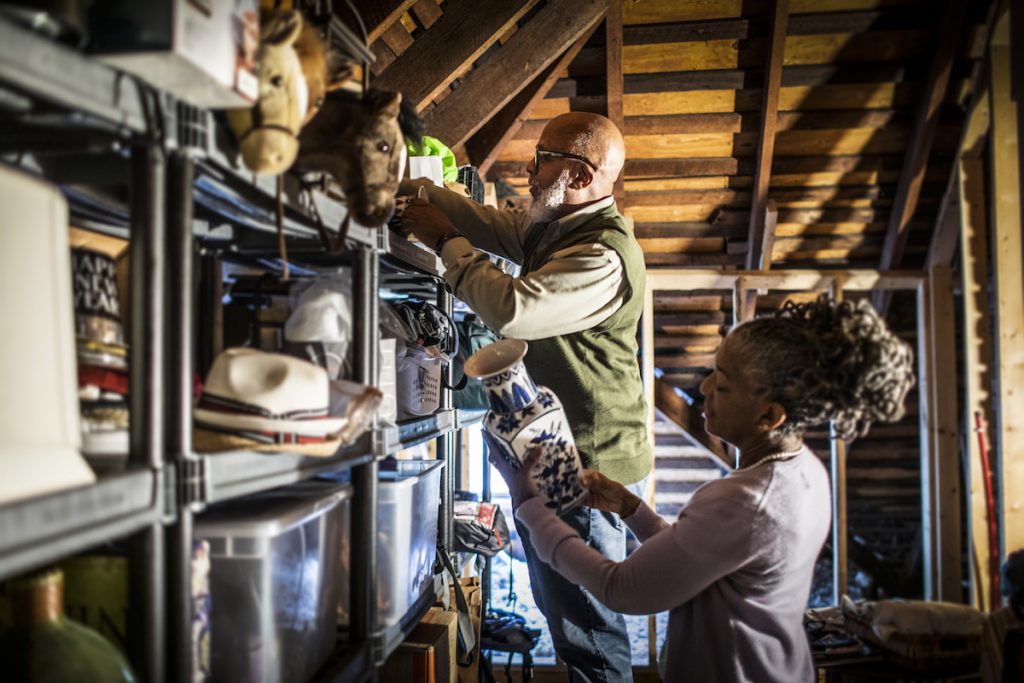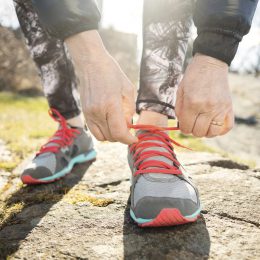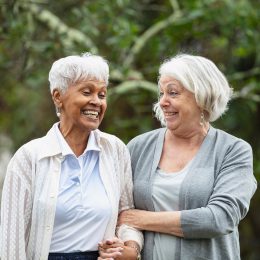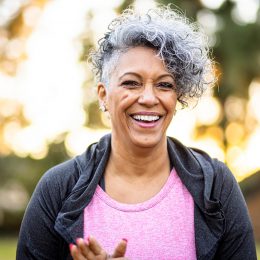Fall Prevention: The SilverSneakers Guide
Even a seemingly minor stumble could increase your risk for serious health issues down the road. Here’s how to stay steady on your feet

As you age, your balance gets less steady, leading to an increased risk for stumbles and tumbles. About three million adults over 65 visit the emergency room every year due to falls, according to the Centers for Disease Control and Prevention (CDC). And that number only accounts for the ones that happened to the people who sought medical attention. In 2019, falls among older adults led to more than 34,000 deaths, making them the leading cause of injury-related mortality for seniors.
If that all sounds a little too gloomy, there is some good news: Falls are not an inevitable part of aging. There are proven ways to reduce your risk of falling, and to lessen the severity of a spill if you do make a misstep. Here’s what you need to know.
Balance training is part of every SilverSneakers group fitness class! Check your eligibility and find participating fitness locations near you here. Or view the current schedule of SilverSneakers LIVE classes and RSVP here.
Why is fall prevention important as you get older?
It’s the ripple effect that can make falls so serious for older adults. They can lead to an injury that can progress into something worse. One out of five falls causes a serious problem, such as broken bones or a head injury, the CDC reports. More than 800,000 people are hospitalized every year because of a fall injury, most often due to hip fracture.
And here’s why everyone should do their best to avoid hip fractures: They can affect your mobility — sometimes permanently. A 2016 BMC Geriatrics study estimated that about 10- to 20 percent of hip fracture patients had to move to assisted living as a result of the injury.
Brain injuries are another common reason people may be hospitalized after a fall. Head trauma can seriously affect your memory and cognitive function, and if you take blood thinners, a fall can lead to more serious head injuries, the CDC notes.
What increases my chance of falling?
There are several risk factors that up your chances that you will take a fall. And the more of these that you have, the more likely you are to slip or trip.
Keep an eye out for these indicators:
- Weakness in the lower body
- Vitamin D deficiency
- Having trouble walking
- Vision issues
- Foot pain or improper footwear
- Home hazards like uneven stairs, slippery throw rugs, or poor lighting
- Dehydration
- Urinary tract infections
- Heart issues like atrial fibrillation
- Low blood sugar
- Pneumonia or other illness
- Low blood pressure, especially if it drops while transitioning from sitting to standing
Side effects from certain medications can be another major risk factor. Both prescription and over-the-counter medications may increase your risk of falling depending on their side effects. For example, over-the-counter sleeping pills may cause lightheadedness or drowsiness that can increase fall risk. Other medication side effects include low blood pressure, delirium, impaired alertness, dizziness, and blurred vision.
A 2016 JAMA Internal Medicine study of Medicare beneficiaries who suffered a hip, shoulder, or wrist fracture found that nearly 75 percent of study participants had been taking at least one drug that’s known to increase fall risk or decrease bone density.
The types of medications that are problematic for balance include:
- Tranquilizers
- Sedatives
- Pain medicines
- Anticholinergic medicines
- Antidepressants
It might not always be a single medication that’s responsible, but rather the interaction of multiple medications. Research from Johns Hopkins University suggests that when you take five or more medicines, the risk for falls goes up.
Recommended reading: 7 Questions to Ask When You Feel Dizzy
What role does balance play in fall prevention?
A steady sense of balance is key for fall prevention. It’s what helps you stay on your feet while you walk, run, or rotate. If you feel like you’ve lost some of your ability to balance well, you’re definitely in good company. It’s common to see this capability diminish with age, and that’s especially true if you’re on certain medications or you have hearing or vision issues that can impact your ability to navigate.
Press play to try two balance checks that you can do at home:
What type of exercises help with fall prevention?
The great news is, almost all physical activity helps lower your risk of falls. Movement improves your body awareness and it helps build bone density and muscle mass.
But since falls tend to happen during everyday actions like climbing stairs or traversing a slippery floor, it’s particularly useful to focus on moves that are part of functional training, which helps strengthen your body for everyday activities.
Functional training focuses on moves like this:
- Squatting
- Lifting
- Pushing
- Pulling
- Carrying
- Stepping up and down
- Balancing
- Walking
- Reaching above your head
- Twisting
These types of moves require multiple muscle groups to work together, boosting coordination and allowing you move in different planes of motion—like from side to side and back and forth. Doing this helps improve joint health, and it gives you a better understanding of the way you move in general.
Every SilverSneakers class features movements like these. Many classes also use equipment like resistance bands, dumbbells, and fitness balls that can help you move in different ways.
A good class to try is SilverSneakers Circuit. This beginner-friendly class includes fall-prevention drills and exercises to improve your strength and endurance. It’s offered both in-person at participating fitness locations and online with SilverSneakers LIVE.
Are there simple exercises I can do anywhere to help with strength and balance?
Absolutely, yes. Turning everyday movement into a quick exercise session is easy, and it doesn’t require specialized equipment. Just be sure to get your doctor’s OK before beginning any new exercise program.
Try these as a starting point:
Sit to stand. Using a sturdy chair, practice standing up and sitting down without using your hands. In the beginning, you may need to use the armrests or a table in front of you. But with practice, you can do it with just your lower body and a little momentum.
Balance on one leg. With support nearby like a wall, back of a chair, or table, lift one foot from the ground and hold it for 10 to 30 seconds. If this is too challenging, try just a few seconds until you get stronger.
Side leg raise. Also with support close by, raise one leg to the side and hold for 10 to 30 seconds. This can help get you used to moving your legs in a different plane of motion, rather than constantly doing the back-and-forth movements involved with walking.
Press play to try a 10-Minute Active Balance Workout:
Recommended reading: Take the 7-Day Better Balance Challenge
I’m afraid of falling. Can exercise help with that?
Most definitely. As you gain more confidence in your balance and strength, it can significantly reduce your fear of falls and life-threatening injury. That’s a huge win, because research suggests that feeling anxious or worried about falling can increase the likelihood that it will happen.
Subscribe to our newsletter
It's quick and easy. You could be one of the 13 million people who are eligible.
Already a member? Click to discover our 15,000+ participating locations.
Follow Us
When you’re feeling scared or timid, it can make you walk more hesitantly, which changes your gait. Then you could wind up doing the very thing you’re dreading the most — falling down.
Feeling stronger and more balanced are essential to fall prevention, and you can rest easy knowing the increased muscle mass and higher bone density that comes from exercise could make a fall less severe if it does happen.
Are there home-safety strategies that can reduce my risk for falls?
There are plenty of them, and there need to be: Six out of 10 falls happen at home, according to the National Institute on Aging.
Evaluating your surroundings is an essential part of fall prevention. Here are some things to consider:
- Have handrails on both sides of the stairs and make sure they’re securely fastened. Hold them every time you go up and down, even if you think you don’t need to.
- Make sure there’s good lighting throughout your home, but especially in hallways, on stairways, and in the bathroom. If you don’t like turning on the lights when you get up in the middle of the night to use the bathroom, use nightlights.
- Keep all pathways in your home clear and uncluttered, and don’t leave shoes or clothes on the floor near doorways or by stairs.
- Secure all rugs and carpeting so they won’t shift beneath your feet. Throw rugs are a frequent cause of falls, so consider adding no-slip strips to the bottom of them.
- Place non-skid strips or mats on all surfaces on the bathroom floor that might get wet.
- Install grab bars near toilets and inside the shower if balance is an issue.
- Keep electric cords away from high-traffic areas.
- If you have a dog or cat, keep an eye out for them when you’re walking around your house. Pets can be a tripping hazard if they move in front of you unexpectedly.
Also consider what would happen if you did take a spill. Keep a telephone or medical alert device near the bed, or with you at all times if you’re particularly unsteady on your feet. There are some remote monitoring services that can be contacted immediately in the case of a fall.
The SilverSneakers Home Safety Checklist is a great resource for helping to identify areas in and around your home where simple changes can help prevent falls.
When should I talk to my doctor about fall prevention?
There’s no time like the present! It’s better to have a conversation with a doctor before a fall happens than waiting until you’re bedridden in an emergency room. At your next wellness visit, ask for a medication review and bring in a list of over-the-counter medications and supplements you’re taking.
Your doctor can tell you whether they may interfere with your medications in a way that causes balance issues. At that checkup, you can also ask for testing that spots nutritional deficiencies that could contribute to your fall risk, such as a low level of vitamin D.
Having a better understanding of your bone density is also a good idea, so consider being tested for that. And measuring how your blood pressure changes when you stand up is also a way to monitor if dizziness may be contributing to unsteadiness on your feet.
If you’ve already had a fall, even if it seemed minor, see a doctor if there’s ongoing pain or loss of mobility. People who have fallen before are at higher risk for doing it again, reports the CDC. Implementing prevention strategies is a much better game plan than waiting to see if you’ll fall again.
But most importantly, if you want to stay upright and injury-free, get active. If you’ve mostly been sedentary in recent years and unsure about how to start, ask your doctor for a referral to a physical therapist or occupational therapist who can help create a tailored plan that gets you on track with mobility, balance, and strength.
See Our Sources:
General info/facts: Centers for Disease Control (2021). Older Adult Fall Prevention
Hip fracture/disability: BMC Geriatrics (2016). A critical review of long-term disability outcomes following hip fracture
Factors increasing risk: Centers for Disease Control (2021). Facts About Falls
Medications: Harvard Health (2019). How medications can affect your balance
Study on medication and fall risk: JAMA Internal Medicine (2016). Patterns of Prescription Drug Use Before and After Fragility Fracture
Balance effects: Johns Hopkins Medicine (2022). Fall Prevention: Balance and Strength Exercises for Older Adults
Home safety review: National Institute on Aging (2017). Fall-Proofing Your Home
Take Your Favorite SilverSneakers Classes Online!
SilverSneakers members can access live fitness classes and wellness workshops through SilverSneakers LIVE. See the latest schedule and RSVP for classes here.
Not a member? If you have a Medicare Plan, it may include SilverSneakers — at no additional cost. Check your eligibility instantly here.
Not eligible for SilverSneakers? You can still get 200+ free SilverSneakers On-Demand videos and stay in touch with us by creating your online account.





